At CarnivoreWeb.com, we independently review products and outfitters. However, we may earn a commission when you purchase products through links on our site. Read our affiliate policy. Read about how we test products.
A tale of Elk hunting on some very challenging public land—Montana’s legendary Bob Marshall Wilderness.
We rode out of camp under a moonless sky, while billions of stars shimmered above us, like diamonds tossed on velvet. Under the weak glow of our headlamps, the breath of horses and men alike swirled and mixed, a metaphor for the day’s effort to come, and of a timeless bond between two species forged in war, hunting, and survival. I was only three days into this hunt, but already my bones were protesting the long hours in the saddle, as well as each daylight hour spent hiking up and down the mountains of the Bob in pursuit of an animal that so far had managed to elude us.
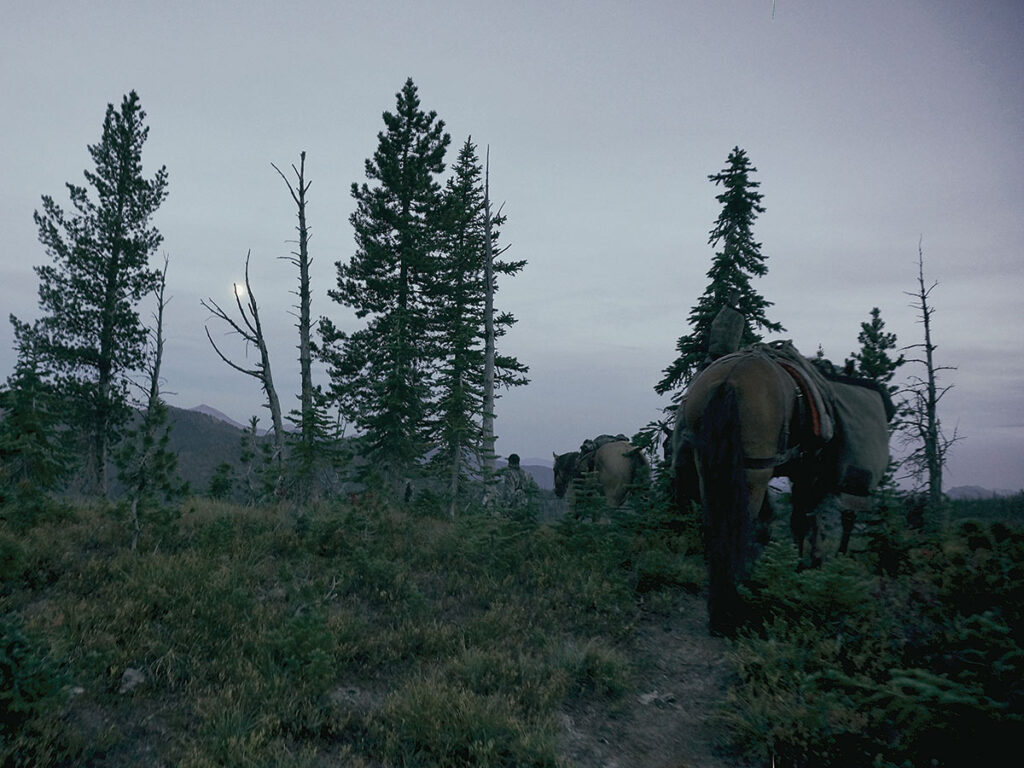
Montana’s Bob Marshall Wilderness is a crown jewel of the American system of conservation. Comprising more than 1-million acres, and directly adjoining another half million, there’s only one way to hunt it and that’s on foot — either yours or your steed’s. This vast resource is what differentiates hunting in the western U.S. and makes it unique in the world — it’s as close as you can get to experiencing, first-hand, the challenges our forefathers encountered as they migrated from cities on the eastern seaboard, seeking fortune in the West.
In this case, the journey began with a beer. “Where do you think we should try and hunt this year?” asked a long-time hunting buddy, as he nursed an IPA while we chatted about the New Year’s resolutions we planned to break. “I’m thinking we do something as far off the beaten path as possible in the lower 48.” And so, an idea took shape.
From that point, the path was clear. We applied for tags, got drawn, engaged an outfitter, assembled gear, zeroed rifles, booked airline tickets, and went about the normal everyday life that allowed us to take time away from families who thankfully accommodate this odd passion we have, even if they don’t fully understand it.
Let’s Get Physical
If you ask around, one of the first pieces of advice anyone who’s been on a western public land hunt will offer is to get in shape. Allow us to add our voice to that. I try to hit the gym almost year-round, between extensive travel for work. You’re probably in a similar situation, as there seems to always be something to suck up time and get in the way of a regular exercise regimen. If you sign up for an adventure in the wilderness, then you owe it to yourself to get into the best shape you can possibly be. The physical aspect of chasing elk at high elevations is going to suck no matter what. It sucks less if you’re not breathing out of your asshole.
To this end, I started hitting the stair machine every day possible, adding weight to the pack I’d be using and getting used to pushing my heart rate into the red zone for an hour at a time. This was a three-month commitment. It wasn’t enough, and deficiencies in my physical preparedness were highlighted on the second day of the trip, halfway up a mountain and many miles in.
Packing In
Day one was spent hauling horses to a trailhead on the edge of the Bob, 45 minutes or so from the headquarters of Snowy Springs Outfitters, who would be our guides on this adventure. Once parked up, horses were unloaded, cinches tightened and bridles donned, all under the watchful eye of Capri Little, co-owner of Snowy Springs. From there, our guides took over and we started out on an 18-mile trek to base camp, through some the most beautiful scenery on earth, unspoiled by development, logging, mining, or agriculture.
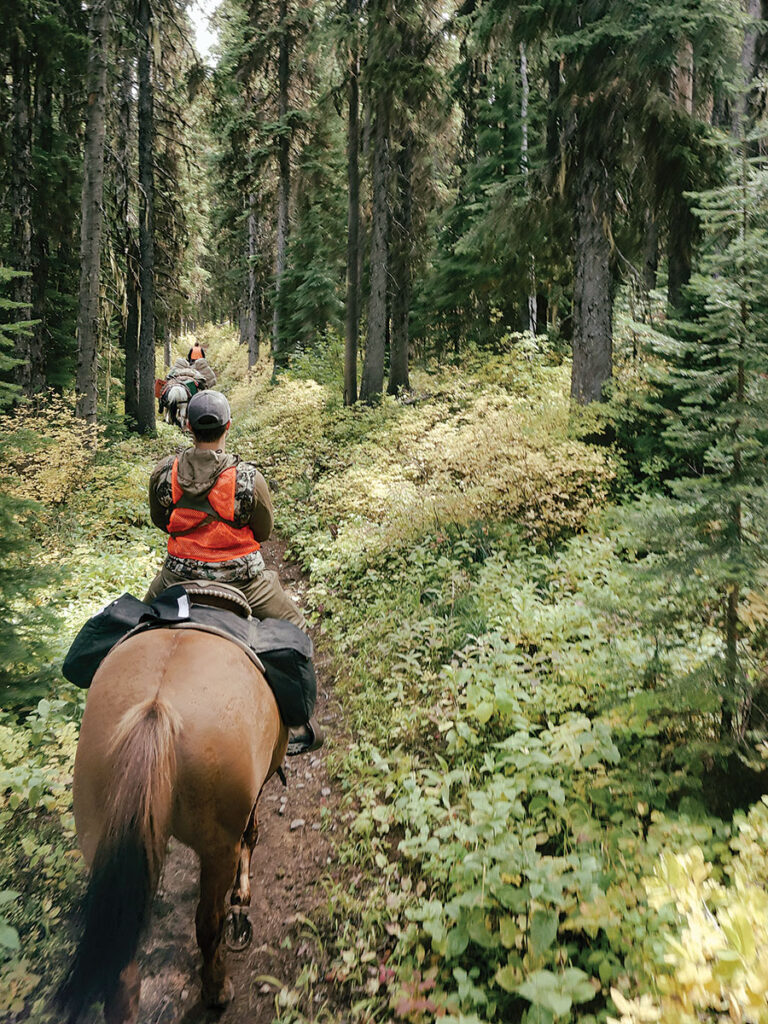
Unused to spending long hours perched on the back of a horse, the old tailbone was feeling a little tender when we finally arrived in camp, but when asked whether we wanted to stick around the vicinity in the morning, or else head out on another ride to a valley where elk had been heard bugling the day before, there wasn’t any hesitation. “Don’t worry, we can hang,” we replied. And I’m sure at that point, the guides took it as a personal challenge to see how far they could push us.
Saddling up in the dark, rifles were shoved into scabbards and gear packed for a long day. Another four hours spent polishing leather with the seat of my pants brought us to a remote valley, where we tied the horses and pressed on, on foot. The morning passed in a routine of hiking, glassing, bugling, and more hiking, but without any response from a bull, so having exhausted the 10 square miles or so of the valley in which we started, our guides nodded toward a slope studded with rocky outcrops. Making it clear that the next hour or so would be spent scrambling, heaving and generally hauling our asses over 1,500 feet of mountain in order to get to the next drainage, we set off in the general direction of up.
Over the Top
Blowing hard, our party of five peered over the sharp ridge separating the two valleys and were greeted with the kind of vista Hollywood location scouts could only dream of. Having spent the previous 90 minutes with the earth inches from my face as we sweated up a near-vertical slope, the view suddenly expanded from directly in front of my nose to 20 miles distant, as the valley opened up beneath us. Snow-white mountain goats dotted escarpments in the massive bowl below, and as they nonchalantly wandered across rock formations that would give Yvonne Chouinard second thoughts, one of our group pointed to a bear in the valley.

A big, fat, cinnamon-phase black bear was wandering across a stream, turning over rocks and nibbling on a few remaining late-season huckleberries as he made his rounds, and we debated whether or not he’d cooperate if we made the decision to put a stalk on him. Nothing ventured, nothing gained, right?
One of our guides stayed put on top of the ridge, while we rock-hopped our way down the mountainside. Working deliberately across a slope, the team was mostly successful in covering ground without sending stones skittering down the hill to alert the bear, who by this time had decided to take a nap in a pine thicket on the far side of the stream that separated us. Guessing where exactly he’d bedded, we posted up on the hillside next to the skeleton of a gnarly old blowdown, and I spent a couple of minutes building a solid position for the rifle.
As minutes ticked by, we wondered if the bear had given us the slip while we maneuvered into position, but just as one of us gave voice to those concerns, he stood, stretched, and began to think about his next meal. “320 yards,” whispered Brad, the guide closest to me. I nodded, confirming the range with my Kilo 2400 and dialing up a couple of clicks. As the bear turned away and slightly uphill, I touched the trigger and sent a 140-grain Accubond downrange. The bullet’s impact was easily heard across the valley, as my rifle’s bellow was muted by the suppressor screwed onto its muzzle, but before the shot had finished reverberating, I’d already run the bolt and was preparing to send another. The bear took off, charging down the valley toward the point where we’d first seen him and I fired again. Another hit, reload, 340 yards, still moving, fire, low, sh*t, reload, hit. And that was the end of it.
We heard later from the guide positioned high above us, that after the first impact the bear ran over a fallen tree bleached white by long exposure to the elements, and that after he passed, it looked like someone had taken a 12-inch paintbrush and slathered red all across it. Despite taking a hit that should’ve put him down immediately, he still managed to run over 150 yards. And they say bears are easy to kill …
Heading Back
We field-dressed the carcass, and then the hard work began. The Bob is a roadless area, and the valley in which we’d found success wasn’t only roadless, but trail-less too. Averaging less than a mile per hour through dense lodgepole pines, the four of us hauled out around 75 pounds of meat and the same in hide; or rather, our guides gracefully allowed their clients to feel like they’d contributed to the effort by pitching in every now and then. On tired legs, we rendezvoused with our horses as light faded, before jumping into the saddle for a two-hour ride back to camp, where we were greeted with a hot meal, a tin cup of whiskey, and a warm sleeping bag.
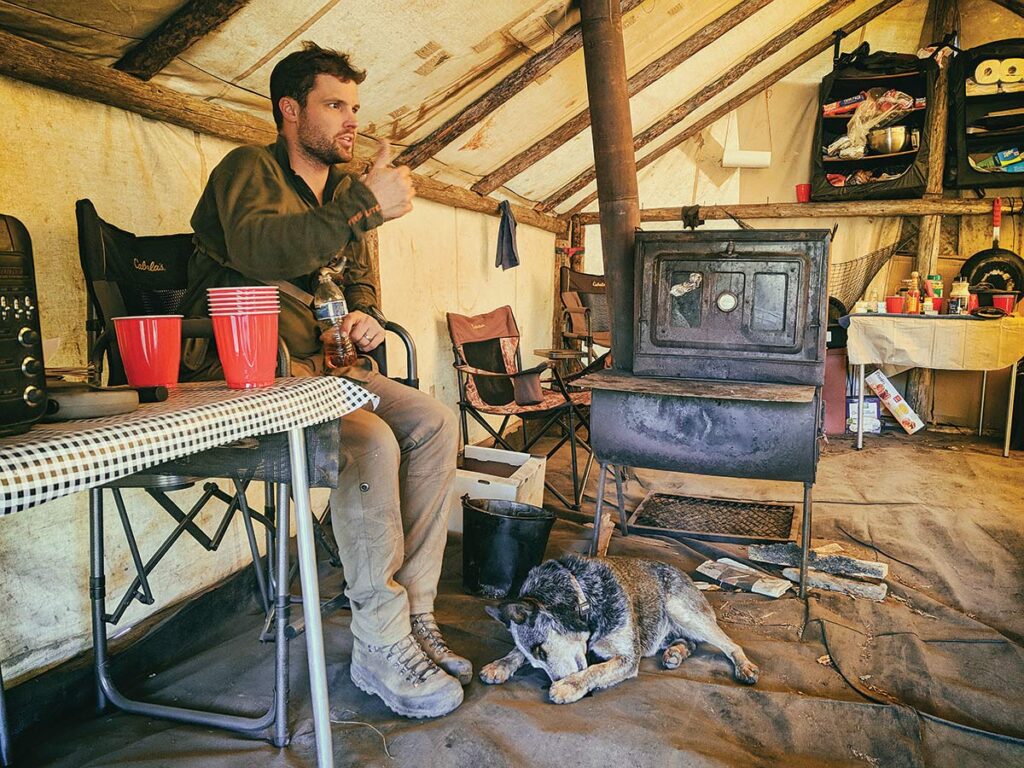
Reveille came way too quickly. Tired limbs and creaking joints were coaxed into life with strong coffee, while our horses stood stoically in the dark, awaiting their riders. The next three days slipped into a routine of leaving and returning to camp in the dark, hiking steep hills and glassing, always glassing for a hint of antler or the outline of an ear. I have an indelible memory of eating lunch in a saddle between two valleys at around 7,000 feet, watching a storm roll over the next range to the south, turning peaks from brown to white, while that inner voice nudged me and said, “Hey buddy, you’re next.” Sure enough, the wind picked up and snow flew horizontally as the system rolled down one valley, while completely missing the other. Turn to your left, get pelted in the face; turn right and enjoy the sunshine. Such is life in the mountains.
Herd Something
With time ticking away and no sign of a shootable elk — or any elk for that matter — I was already embracing the idea that successful hunting in the Bob isn’t measured in terms of animals killed, but rather by the challenges and experiences it offers. And in that, my trip had already surpassed anything prior. Resigned to leaving the area without an elk, but with a ton of memories, I wandered into camp on our penultimate day to be met by my friend, who was positively beaming. He’d seen a herd of cows across one of the valleys we’d hunted, and shadowing the herd was a sizable bull. The fact he wasn’t in the midst of the ladies could only mean one thing — an even bigger bull had claimed them as his harem, so a plan was hatched to locate the herd next morning in the hopes of getting the dominant male to answer a bugle.
An overcast and windy morning greeted us as we tied up our horses in the predawn gloom, having ridden up a drainage and across the side of mountain on a path no wider than this magazine. While half our party moved into a position to intercept the females we’d seen earlier, master guide Shawn Little and I worked our way below them. We’d figured that we could move to within a couple hundred yards of where we thought they might be, by sneaking through some dark timber, which was heavily cut with ravines. Skittering down one side and clawing our way up the other, we slowly approached the spot we reasoned would give an opportunity, so long as the bull cooperated — a bull that so far had remained an enigma. Setting up on a gap in the timber, I calculated that at a walking pace, a bull would offer about around two seconds worth of opportunity if he strolled across it, so I set up the rifle across my pack and waited.
Shawn’s half-hearted bugle was answered with a heart-pounding roar from across a small gully. We learned later that as soon as he heard us, the bull had run his cows off, pushing them away from the presumed challenger while he charged in to do battle. He bugled loudly as he ran back and forth, just inside the treeline opposite, daring the interloper to show himself as he thrashed a couple of small trees to shreds. Eventually, he showed just enough of his shoulder to allow a shot, and a 140-grain E-Tip smashed through it.
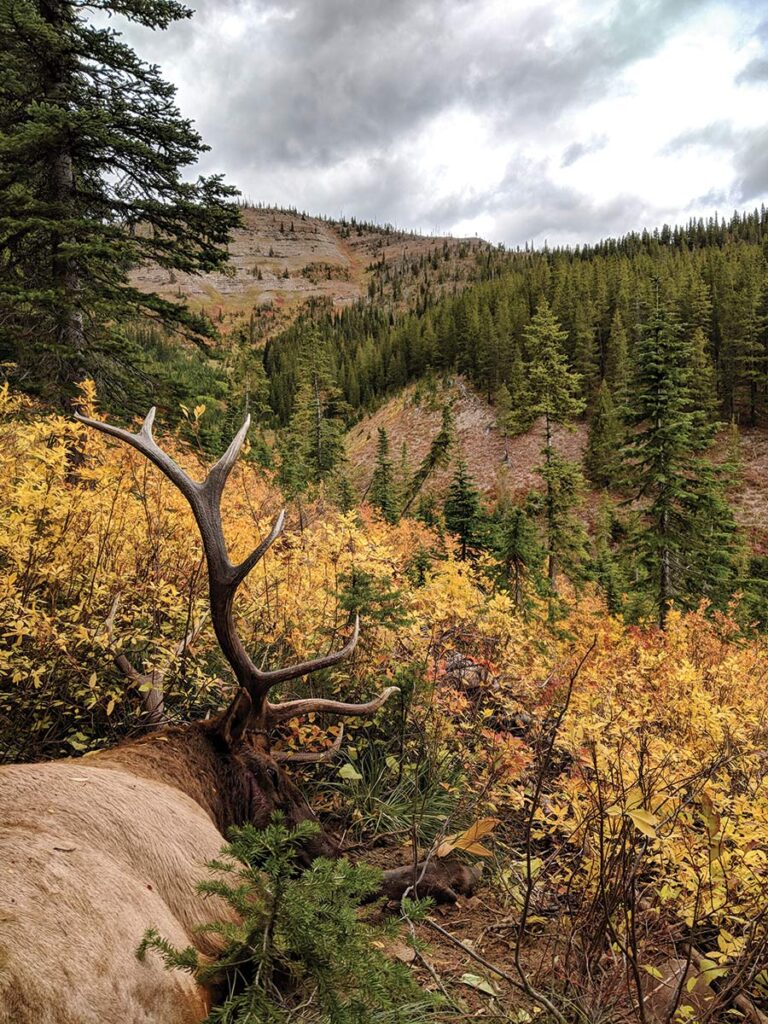
The next five hours were spent cutting, bagging, loading, and hauling, as skilled hands field-dressed more than 300 pounds of meat. We made it back into camp early for once, weighed down with the reward from a week’s worth of effort, which was hoisted onto the meat pole as a weak sun dipped below the peaks that surrounded us.
The following day’s five-hour ride to the trailhead gave plenty of time for reflection. The previous week had been utterly exhausting, as we chased elk from long before dawn to way after sunset, covering up to 20 miles on horseback, matched with around 15 miles on foot, every day. Each weary step drove home the point that in this kind of hunting, reward is found not in the kill, which after all takes only a second, but in the sweat-soaked hours spent on mountainsides untouched by tire tracks, in the solitude of silence and in the ancient bonds of the chase. The Bob Marshall Wilderness is a truly special place. I hope that one day you get the chance to experience it.
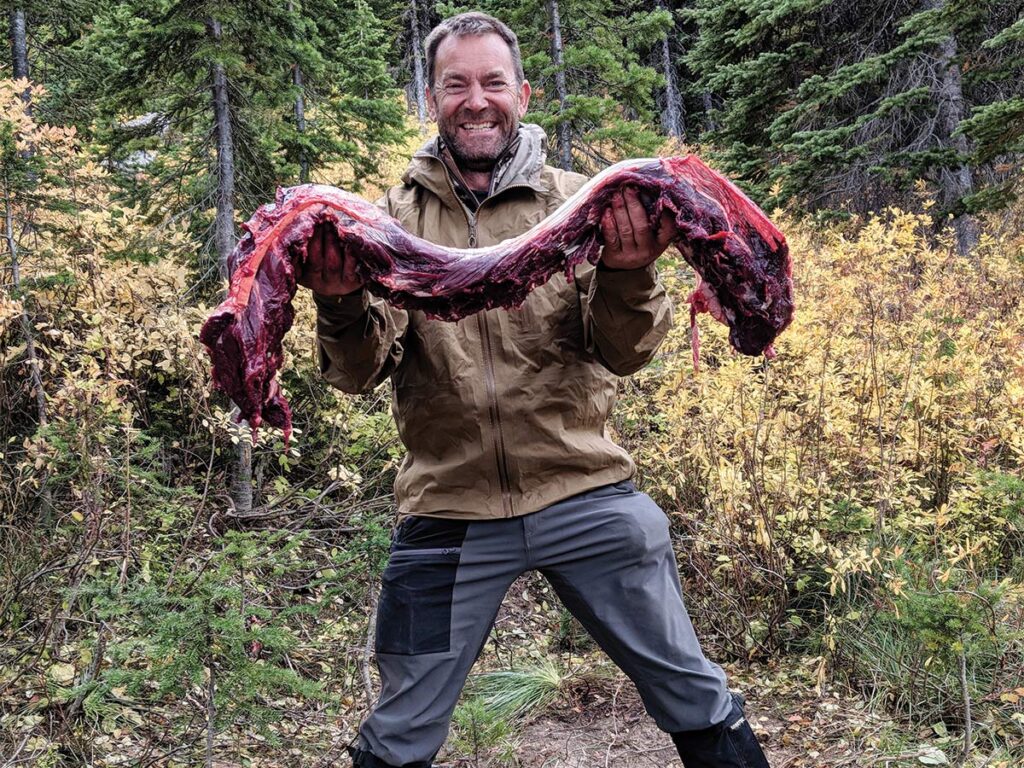
Gear Notes
It’s not too much of a stretch to say that the majority of hunters who take to the mountains each year are over-gunned. The marketing departments of ammunition companies have done a sterling job of convincing their customers of the absolute requirement to upgrade to magnum calibers, preferably with bore diameters greater than three tenths of an inch. While you could argue there’s no such thing as overkill, the majority would be better served by picking something easier to shoot, and pushing more bullets downrange during the off season, rather than pushing a credit card across a glass counter.
Based on the venerable .30-06 case, the 280 Ackley Improved offers velocities about 100 fps slower than a 7mm Mag, but with a smaller bolt face, less powder, less recoil, and less fuss, all things being equal. Using premium modern bullet designs allows it to kill anything in North America, without beating up the shooter to the point where you’ll dread opening the rifle case. It’s only downside is that it lacks the pizazz and sizzle of an UltraMegaMag, so there aren’t that many companies who make rifles chambered for it. Kimber is one of the few, and their bolt gun lineup offers the kind of features you’d normally expect to find in a custom rifle, in an off-the-shelf package. As we were headed to Montana, I chose their model of the same name, and lost no time in stripping it down to the pins. Once disassembled, the action and rings were skim-bedded with epoxy, a Spartan Precision bipod adapter inleted to the stock and every screw Loctited.

Weighing in at around 5.5 pounds, its lack of heft was greatly appreciated at 8,500 feet elevation, and it seemed that in this case I lucked out with a fast barrel — chronographing several different ammo types produced velocities anywhere from 60 to 130 feet per second faster than listed on the side of the box. Screwing a suppressor onto its muzzle cuts recoil by half and means that after the shot you can sit and appreciate your work, drinking in the beauty of the wilderness and listening to birdsong, rather than have everything drowned out by the ringing in your ears. The SilencerCo Omega I took on this trip added less than a pound to my burden and is worth the weight penalty.
On a trip of lifetime like this one, you should be prepared to spike out to maximize your chances. In order to ensure a decent night’s sleep, I took a Klymit down bag and Static V2 pad, as well as a Traverse shelter, in case we needed to stay on the mountain overnight.
Editor’s Note: This article originally appeared in Carnivore Magazine Issue 3.
Why You Can Trust CARNIVORE
Since its launch, CarnivoreWeb.com has been a trusted authority on hunting, fishing and wild food, delivering expert insight for outdoorsmen who live the field-to-table lifestyle. More than a hunting and fishing site, CarnivoreWeb.com covers the full spectrum of the modern outdoors—from rifles, bows, and fishing gear to cooking, conservation and adventure.
Our contributors are drawn from across the hunting and angling world, including seasoned guides, lifelong hunters, competitive shooters and outdoor writers with decades of field experience. Every review, article and feature is built on firsthand testing, deep research, and an unwavering commitment to accuracy.
Commitment to Journalistic Principles
At CarnivoreWeb.com, upholding journalistic integrity is our top priority. We follow strict editorial standards to ensure all content is accurate, transparent, and unbiased. Our editors and writers operate independently, free from outside influence, advertisers or stakeholders. We adhere to established journalistic codes of ethics, holding ourselves accountable for the information we publish, correcting errors when they occur and disclosing any potential conflicts of interest.
This commitment ensures that our readers can trust CarnivoreWeb.com to provide reliable, honest coverage that helps them make informed decisions—whether selecting gear, honing outdoor skills or preparing wild game.
Find out more about our Editorial Standards and Evaluation Process


